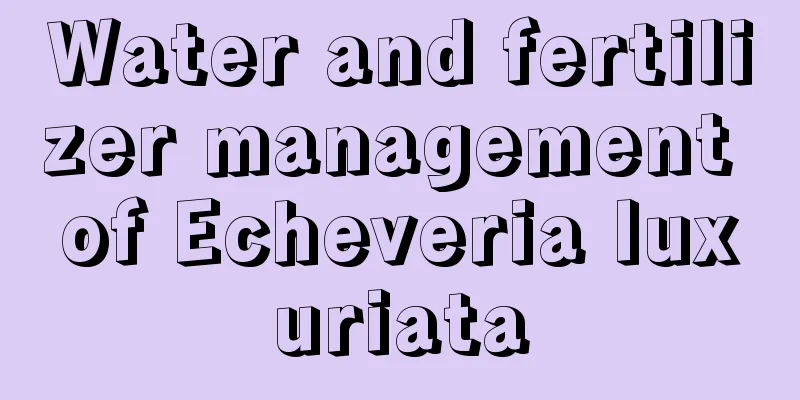Water and fertilizer management of Echeveria luxuriata

Watering tips for Echeveria luxuriataIt is recommended to water Echeveria Lu only after the soil is dry, because Echeveria Lu is drought-resistant and afraid of waterlogging. If the soil in the pot is too moist, it will easily cause the roots of Echeveria Lu to rot, which will damage the plant. The temperature is low in winter and the soil is too wet, which can easily freeze the soil and cause frostbite to the plants. Therefore, if the temperature can be kept above 0 degrees in winter, you can water it. If it is below 0 degrees, stop watering and keep the soil in the pot dry. When watering in winter, you can pour a little water on the roots of the plant at the appropriate time, but avoid watering with large amounts of water. As the temperature rises in spring, you can slowly resume normal watering. When the temperature is high in summer, you should slowly cut off the water and move the plant to a bright and ventilated place. As the temperature begins to drop in autumn, you can slowly resume watering. Fertilization techniques for Echeveria luxuriataWhen fertilizing Echeveria lucidum, you can apply slow-release fertilizer, and some people also have good results with base fertilizer. Generally, Echeveria Lu's fertilizer should be applied once a month during the growing period. The amount of fertilizer should not be too much, and it can be applied thinly and frequently. When repotting Echeveria lucidum, you can apply some basal fertilizer. Precautions for water and fertilizer management of Echeveria LuWhen watering Echeveria lucidum, do not water the center of the leaves, as this may easily cause the leaves to rot. Do not spray or overwater when watering in winter. When fertilizing, do not apply too much fertilizer at one time, as excessive fertilization will cause seedling burn and plant rot. Also, do not sprinkle liquid fertilizer on the leaves to avoid burning the leaves and affecting the appearance. |
<<: How to plant orchids in pots
>>: Things to note when repotting Echeveria luxuriantii
Recommend
Can yogurt be used as fertilizer?
Yogurt as fertilizer Generally speaking, yogurt i...
What to do if geranium leaves turn yellow
Normal update If you are raising geraniums for th...
The Flower Language of Pansy
1. Flower language Pansy is a common roadside gre...
Yellowing of hyacinth leaves and treatment techniques
reason Water yellow Excessive watering causes yel...
Ice Cream Tulip
Ice Cream Tulip The Ice Cream Tulip is a new and ...
Is it better to mix bone meal with water and water the flowers or bury it in the soil (how to make bone meal to fertilize flowers)
What are the benefits of using bone meal to water...
How to grow jade pendant succulents to be fat, plump and long
Jade Pendant Succulent Growth Conditions 1. Soil:...
The flower language and cultural legend of perfume grass
Origin of the name of perfume grass The reason wh...
How to grow a fortune tree faster
1. Soil environment If you want it to grow faster...
When does rose bloom?
1. Flowering period Roses usually bloom in mid-to...
Do roses like the sun? Can they be placed in the sun?
1. Do you like sunbathing? It is a light-loving p...
How to make strawberries sprout quickly
Strawberry germination environment Strawberries p...
How to care for and water Schefflera?
Schefflera , also known as Schefflera arborvitae ...
When is the best time to sow shepherd's purse?
Shepherd's purse belongs to the genus Capsell...
How to care for cymbidium flowers during their blooming period? Can fertilizer be applied during flowering?
1. How to grow during the flowering period 1. Sui...









